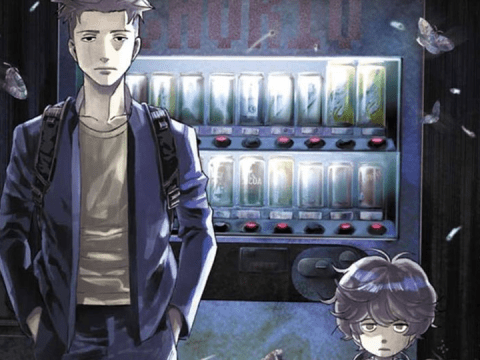 While it used to be that the anime and manga world in the US was all about “mature content,•bCrLf and much of the stuff out there tended to center on people getting chopped to bits with katanas, blown up, and/or raped, it would seem that at some point between the Pokemon fad, the Yu Gi Oh fad, and the Dragon Ball Z fad, the gears were shifted and the more kiddie-oriented fare gained dominance. Whereas in high school my friends and I would spend the day at Borders reading Blade of the Immortal and Ghost in the Shell, then come home with a Ninja Scroll DVD and finish the day off laughing at penis jokes over my old Goldenboy VHS set, nowadays when I return to my old stomping grounds at the book store, I can’t seem to find my way around the massive quantities of shonen and moe hogwash bursting from anime and manga store shelves.
While it used to be that the anime and manga world in the US was all about “mature content,•bCrLf and much of the stuff out there tended to center on people getting chopped to bits with katanas, blown up, and/or raped, it would seem that at some point between the Pokemon fad, the Yu Gi Oh fad, and the Dragon Ball Z fad, the gears were shifted and the more kiddie-oriented fare gained dominance. Whereas in high school my friends and I would spend the day at Borders reading Blade of the Immortal and Ghost in the Shell, then come home with a Ninja Scroll DVD and finish the day off laughing at penis jokes over my old Goldenboy VHS set, nowadays when I return to my old stomping grounds at the book store, I can’t seem to find my way around the massive quantities of shonen and moe hogwash bursting from anime and manga store shelves.
As such, any time a more mature-themed title arrives for review here at the Otaku USA offices, it’s a breath of fresh air. Speedgrapher is one such title. The main character is a former war photographer named Saiga who used to spend his time running through the jungle capturing death and destruction on film. After throwing himself in the midst of warfare caused him near-fatal injuries, he’s given it up, and now makes a living prowling the streets at night snapping shots of crime and corruption for the newspaper. As he passes, he’s often greeted by prostitutes loitering on the corner who know him by name, and he’s frequently pressed at gunpoint for sexual favors by a busty leather-clad female cop with a gun fetish. Finally, when he comes home at night, he has to listen to his gay next-door-neighbor’s boyfriend problems.
.psd.gif)
The action picks up when Saiga gets himself in too deep investigating an underground secret club run by yakuza. After spotting every local politician there partaking in all sorts of lewd acts and stumbling into the middle of an occult ritual, Saiga unwittingly receives a supernatural power which causes things to blow up whenever he snaps a picture. That’s right; he blows stuff with his camera!! That’s almost as awesome as sharks with frikkin’ lasers!!! As his presence is discovered and he must make a hasty escape from the gun toting, sword wielding club bouncers, he is forced to use his camera as a weapon, and starts dismembering people with sparkling explosions left and right!
Unfortunately, the creators clearly could not handle all this awesomeness, and had to add some sort of innocent element to the series, probably thinking it would lend “balance•bCrLf to the story. This comes in the form of a shy, sheltered 15 year-old schoolgirl named Kagura, the protection of whom suddenly becomes Saiga’s life mission. Granted, she comes from a dementedly rich home, where her insane politician mother consorts with yakuza bosses, forces her into anorexia, and administers oral sex to her (female) teachers just to scare her. Kagura is even at the center of some sort of perverted rituals which she’s been brain-washed into, and doesn’t remember when she wakes up. However, you’d never know it by her character, because she acts just like every other school girl in every other anime you’ve ever seen, displaying not even a hint of any emotional problems as a result of her ordeals, much less any sort of personality.

Just when you’re really starting to be amazed by the crazy turn of events constantly unfolding in Speedgrapher, the series locks into predictable formula. More interesting supporting characters like the tough female cop and the gay neighbor fade into the background, and Kagura hogs most of the screen time. She injects just enough moe dullness to the scene that you nearly forget all the sex and violence which initially allowed the series to grab your attention. She is constantly playing the generic damsel in distress, getting attacked or captured, and then Saiga has to save her for the 15th time. There is a villain of the week, and Saiga’s explosive camera work always saves the day.
This formula pervades a sizeable chunk of the series’ episodes, and makes things considerably more mundane and predictable, but does not completely ruin it. Each new villain has his/her own bizarre supernatural powers comparable to Saiga’s. This power is always derived on the subject’s “deepest desires•bCrLf, which basically means that each nemesis and their abilities are based on some psychotic complex, the back-story of which may or may not be told in a series of flashbacks. Frequently each villain has some manner of surprise invulnerability to Saiga’s explosive camera powers, so part of the thrill is watching our hero figure out just how to kill them.

Sometimes these characters, their powers, and their stories are refreshingly bizarre and entertaining. For example, the first major villain is a male ballet dancer whose desire to bend and contort into elegant moves with the music grants him the superhuman ability to stretch his body like rubber. He works as a hit man contracted by the yakuza, and dressed in spandex bondage gear; goes on insane rampages using his arms to literally slingshot himself into the air across rooftops, screaming in a hilarious high-pitched wail, ripping the heads off of his victims while bullets sink into his body then bounce off harmlessly.
Other villains are just sorta lame, like the deranged dentist who grows drill arms from his back, the music aficionado who transforms into a walking, talking subwoofer, or the stamp collector who sticks people to the wall by licking them with his adhesive saliva and leaves them to starve to death! OK, that last one wasn’t real, I admit. On the other hand, seriously, at one point a villain is defeated because he attempts to short-out Saiga’s deadly cameras with an electrical charge, not realizing the difference between digital and analog film cameras, and that film cameras don’t run on electricity. His defeat consists mostly of Saiga laughing at him and flying away in a helicopter.
However, the series’ villains of the week and even its main villains, such as Suitengu the mutant mafia mastermind and his cronies, are responsible for most of the show’s character development. This is partially because Kagura, who is such a central character, is so utterly undeveloped and hasn’t a shred of individuality to her character. Just to be fair, it must be pointed out that as cool and ceaselessly watch-able as he is, Saiga is not quite the most original nor the deepest character either (Spike Spiegel with a camera). Meanwhile, Suitengu’s back story is a closely guarded secret which isn’t revealed till the closing episodes of the series, but he eventually becomes the most sympathetic and developed character in the story. When his world-shattering master plan is finally revealed, not only will you understand his reasons, you may actually wish for him to succeed.
Fortunately, Speedgrapher‘s ending follows neither the typical superhero conventions where good guy kills bad guy, case closed, nor the more recent, over-used post-Evangelion era ending conventions where everyone is killed off for the sake of some vague, ambiguous philosophical message. The series is resolved in an unexpected yet satisfying manner. It’s not perfect, but it’s better than most, and makes up for much of the predictability in its middle portions.
.psd.gif) Speedgrapher is a mixed bag. Its premise and many of its elements are unusual and refreshingly adult, and yet large chunks of it drag with episodic convention and school girl wish-washery. Some episodes require a fair bit of patience to get through, while others are quite exciting, even addicting, and will have you rooting vehemently for Saiga, even if he is just saving that stupid girl again. If you’re looking for a more serious title, Speedgrapher is not the absolute best out there, but it comes recommended and will keep you enthralled for a while if you’re just desperate to watch anything more adult than the shonen and moe swamping store shelves.
Speedgrapher is a mixed bag. Its premise and many of its elements are unusual and refreshingly adult, and yet large chunks of it drag with episodic convention and school girl wish-washery. Some episodes require a fair bit of patience to get through, while others are quite exciting, even addicting, and will have you rooting vehemently for Saiga, even if he is just saving that stupid girl again. If you’re looking for a more serious title, Speedgrapher is not the absolute best out there, but it comes recommended and will keep you enthralled for a while if you’re just desperate to watch anything more adult than the shonen and moe swamping store shelves.
Studio/Company: FUNimation
Available: Now
Rating: 17+







